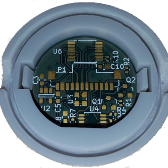Integration of Sensors into Embedded and Networked Sensor Systems
The demands placed on sensors and sensor systems are constantly growing. At the same time, the systems must become ever smaller and more energy-efficient. Sensor integration has therefore become much more than the connection of a transducer, but a comprehensive system design from the recording of measured values to data processing and transmission via a communication network.
The wide-ranging expertise at DISS makes it possible to view sensor systems as a whole and to optimize them across borders such as hardware, software or network technology. In addition to know-how, the corresponding infrastructure such as software for PCB and circuit design, climate chamber, repair soldering station, test networks or network analyzers are also available in order to develop, commission, test and characterize integrated sensor systems.

„For the detection of pedestrians, a low-pixel IR sensor was developed into a smart sensor system interconnected with the traffic infrastructure.“
A frequently used principle for the optimization of sensor systems are feedback and event controlled transducers. For example, a transducer can be switched between different measuring ranges and cover several decades of the measurements by an appropriate software design. The same principle can be used for energy efficient operation by switching between an inaccurate but energy efficient mode and an accurate mode with higher resource consumption.
By using digital twins (digital representatives of the sensor hardware), additional extended functions can be created. In this way, functions can be shifted to nodes with higher computing power or energy resources, especially in distributed systems, but also new functions such as electronic horizons can be created that fuse data over the actual coverage area of a single sensor.
Contact: Albert Treytl